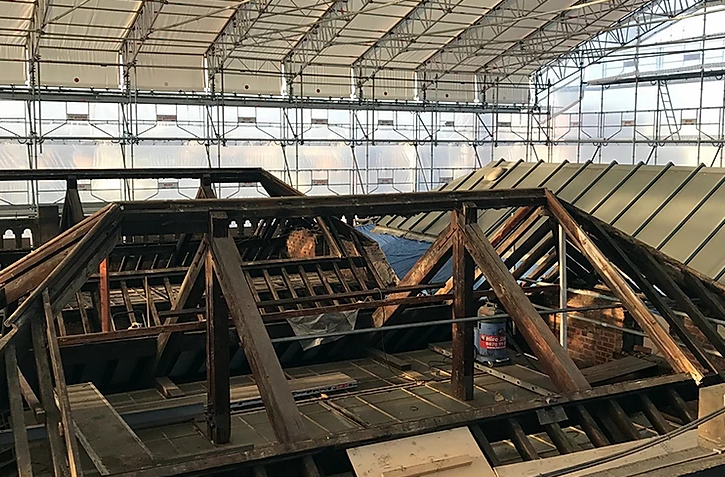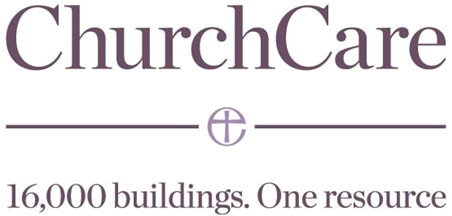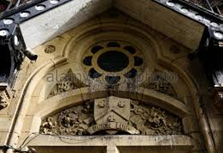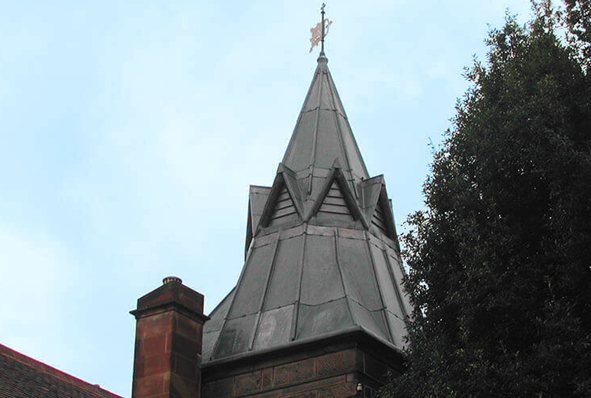Heritage Roofing
Heritage roofing - maintaining our iconic buildings
The UK is home to some of the most iconic buildings in the world, from stunning churches and cathedrals to historic stately homes. Each and every one of these remarkable feats of architecture requires regular maintenance to ensure they remain in the very best condition, allowing them to be enjoyed for generations.
Cathedral Care
Restoration and upkeep of cathedrals
There are some 42 Anglican cathedrals in the UK, not to mention 20 or so Catholic cathedrals. Cathedrals form the most important collection of historic buildings in England. The largest and most ancient are internationally famous, the smallest are usually among the most significant buildings in their region and even the most recent are architectural masterpieces.
Master Craftsmen
Championing our heritage with modern craftsmanship
Twenty years ago, English Heritage (now Historic England) published its first-ever Register of Buildings at Risk across England, which featured nearly 2,000 buildings and monuments that were ‘neglected, broken and unloved’. Recently Historic England was delighted to announce that over two-thirds of those buildings were now safe, in both urban and rural areas right across the country.
Traditional Lime
Lime: it’s better for buildings – and for the environment
It is now fairly well known that cement is not good for old buildings and that lime mortar should be used. But why? What are the advantages and what are the disadvantages? In order to begin to answer those questions it is necessary to understand the nature of traditional building, the process by which buildings used to be built, and how it differs from modern construction, the process by which we build today.
Audio Visual
Audio visual equipment in church buildings
This guidance is issued by the Church Buildings Council under section 55(1)(d) of the Dioceses, Mission and Pastoral Measure 2007. As it is statutory guidance, it must be considered with great care. The standards of good practice set out in the guidance should not be departed from unless the departure is justified by reasons that are spelled out clearly, logically and convincingly.
Read More...
CRE Events
After the Midlands, onward to Milton Keynes
"CRE Midlands reminded me of the giddy days when it first began – the venue was packed with exhibitors and visitors and there was a busy atmosphere. The whole thing looked great."
Insurance
You need to ensure that reasonable precautions are in place at your church to keep it safe for those who use it. To do this, you need to think about what might cause harm to people.
You will then need to decide if the precautions already in place are adequate. If they are not, you may need to identify further action to prevent any danger. When done formally, this is known as a risk assessment.
Church Maintenance
Church maintenance and repair: Calendar of Care
Just as prevention is always better than cure, maintenance is preferable to major repairs. But, such repairs may not always be avoidable. Church Care offers a monthly guide in our coming issues Starting in Spring
We can help you understand the common problems and areas that need your special attention, and give you tips for regular maintenance schemes.
Pest Control
Michael Palin warns of pest threat to churches
Michael Palin is supporting the future of the UK’s historic churches and chapels with a voiceover for a new animated film. The 80 second animation, produced for the National Churches Trust, highlights why churches are some of the nation’s best loved buildings.
Town Halls
The history of the great Victorian Town Halls of Northern England
From industrial squalor to civic pride, the story behind some of the most impressive buildings of the North involve a unique mix of economics, grand designs and noble sentiments within communities.
Lead Roofing
Lead is one of the oldest materials in the roofing industry and is still commonly used throughout the world today.
Lead roofing is a traditional roofing method which has been used in the industry for hundreds of years, and is therefore proven to be extremely reliable. Lead roofing, and sand-cast lead, in particular is ideal for old buildings such as churches or historical renovations, whereas milled lead roofing is a mass-produced alternative, used for precision and accuracy in homes and commercial buildings alike.
Lightning Protection
When lightning strikes are you protected against this act of God?
The issue of lightning protection in churches is one that has exercised this publication for many years. In this four-part series of spotlights on the issue we will be revisiting various aspects of the subject, beginning with an overview of current thinking.
SEARCH OUR DIRECTORY
Institute of Carpenters
 HERITAGE TIMBER
HERITAGE TIMBER
The rich built heritage we have in the UK is made up of churches, castles, stately homes, private residences and even industrial buildings; a wide and diverse range which help give character to where we live. With over 6 million such buildings, their long-term preservation depends on the specialist skill, knowledge and expertise of talented craftspeople. These once commonplace skills have suffered a decline, but a revival across all craft professions is taking place and opportunities are increasing for young students and career changers alike, with carpentry and joinery particularly in demand.
The restoration and conservation of timber elements within heritage properties can cause controversy, be it differing methods or even necessity. Whether a heritage building is a cathedral or a grade listed home, any conservation, restoration, renovation, repair or maintenance requires experience and specialist skill which few regular contractors have. Knowledge, training and experience are vital for authentic, sympathetic and successful projects, and the Institute of Carpenters has many qualified members who are experts in this field.
When it comes time for repair, replacement, or implementation of a protective measure for a structure, any professional would need to understand much of the following before moving forward. Questions need to be asked, including: what type of wood is it? How old is it? What purpose does the affected wood have – is it decorative or structural? Has it been treated with a preservative? What is happening to the wood and what is causing the current condition? Is the condition reversible, treatable, salvageable? Will it happen again if the same course of action is implemented? If so, what will prevent this condition again? Without asking some of these questions, which anyone qualified and experienced working technically with wood should be able to answer, some clients have had results which were inappropriate, inferior or inadequate.
Technical knowledge, such as that possessed by many members of the Institute of Carpenters, is an applied science, profession, art, or craft. Those educated in the science of wood can become skilled with practice. Those who further develop their skill become artful. True professionals use their applied knowledge to develop their technique, which is the tool of a professional skilled in the science which is wood care and professional restoration.
 Without such experience and professional knowledge, results can range from sheer luck to disaster. A little knowledge is not good for the wood, a wealth of knowledge is far better for it. The Institute of Carpenters has always been associated with the highest standards of craftsmanship and professionalism; standards which are still considered exceptionally relevant by its membership. Prestige, public recognition, quality and skill are just some of the things for which this highly respected organisation stands, but it is the requirement that professionals working in wood must qualify for membership to an accredited standard, that really makes the Institute of Carpenters a cut above the rest, and it is this benchmark which appeals to clients and customers who want craftsmen, rather than workmen.
Without such experience and professional knowledge, results can range from sheer luck to disaster. A little knowledge is not good for the wood, a wealth of knowledge is far better for it. The Institute of Carpenters has always been associated with the highest standards of craftsmanship and professionalism; standards which are still considered exceptionally relevant by its membership. Prestige, public recognition, quality and skill are just some of the things for which this highly respected organisation stands, but it is the requirement that professionals working in wood must qualify for membership to an accredited standard, that really makes the Institute of Carpenters a cut above the rest, and it is this benchmark which appeals to clients and customers who want craftsmen, rather than workmen.
Choosing the right company to carry out specialist heritage or restoration work can be a big decision. The qualifications of all members of the IoC are checked and meet the Institute’s high standards. It is good to look for experience of similar work and excellent references, but the best reassurance is always gained from discussing your individual requirements in detail with members of the Institute of Carpenters in order to find the right professional, and the best solution, for you.
The historic craft of building and working with timber has never been a more relevant and sustainable solution as it is today. The aims of the IoC include promoting and enhancing the role and status of skilled craftsmen and women everywhere; encouraging the highest standards of carpentry and joinery work; and making sure that essential skills are maintained. The IoC might have been founded in the 19th century, but its aspirations are firmly in the 21st.
IoC director Duncan King explains, “It is the understanding that all our members have qualified, either through apprenticeship, NVQs, City & Guilds, our own examinations or significant assessed quality craft experience, that gives our members pride - and give clients reassurance - in our standards.”
“Find A Professional” is the online search facility available from http://www.instituteofcarpenters.com/ and is the latest initiative to be launched by the IoC. It offers anyone with a need for a professional craftsman – from contractors to architects, local authorities to owners of heritage properties – the means to find and contact the right person for their project. Search criteria include location and speciality, such as joinery, cabinet-making or restoration, all drawn from members of the Institute of Carpenters. Mr. King says, “This is a great resource for clients needing high quality services and it’s a great commercial benefit to our members who train and work so hard to maintain standards which are much in demand.”
For information on membership and courses provided by the Institute of Carpenters, visit http://www.instituteofcarpenters.com/ or call 020 7256 2700.
 CASE STUDY
CASE STUDY
The University of Reading in Berkshire contacted Richard Smyth, FIOC, of Carpentry With Care through the Institute of Carpenters. An experienced company in the area was needed to refurbish and rejuvenate the original boxed sash windows housed within the University’s Great Hall, London Road campus, which has been subject to neglect.
The images show a window on the eastern elevation of the Great Hall, which benefitted from a thorough refurbishment of existing frame and sashes. Work included renewal of all sash cords, adjustment, checking and lubrication of pulleys and counter-weights, careful removal and replacement of rotted timber sills, sashes and frame, and discrete security bolts were installed. For preventative maintenance and long term performance, channels were formed to drain rainwater away from each side of the frames, which were primed and finished.
Photography courtesy of Richard Smyth, Carpentry With Care.






































